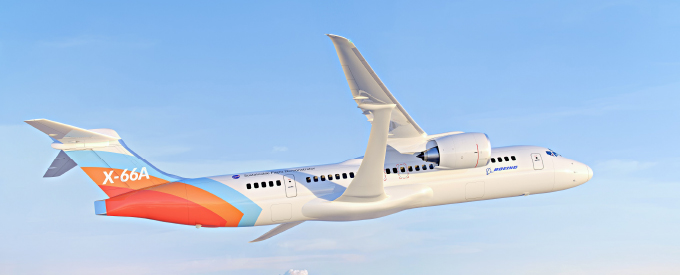2023-09-04
U.S. Airlines Lend a Helping Hand to NASA-Boeing Project
Boeing and NASA recently announced that they would collaborate with U.S. airlines to advise the Sustainable Flight Demonstrator (SFD) project and development of the X-66A research aircraft. NASA and Boeing also unveiled the new X-66A livery at EAA AirVenture Oshkosh.
As part of a new sustainability coalition, Alaska Airlines, American Airlines, Delta Air Lines, Southwest Airlines, and United Airlines will provide input on operational efficiencies, maintenance, handling characteristics and airport compatibility.
The purpose of the Sustainable Flight Demonstrator project is to engage with industry, academia, and other government organisations to identify, select, and mature key airframe technologies, such as new wing designs, that have a high probability of transition to the next-generation single-aisle seat class airliner.
“Hearing directly from the operators during all phases of the Sustainable Flight Demonstrator project will help us understand exact requirements and trade-offs,” said Todd Citron, Boeing’s chief technology officer. “The airlines’ feedback will significantly contribute to the X-66A project learnings while furthering aviation sustainability.”
Sustainable Aviation
Aviation needs to be sustainable so the environment can be protected, the economy can grow, and people can continue to connect in person quickly across long distances thanks to the marvel of air travel. With today’s aircraft fleet and operational efficiency, the estimated worldwide air traffic in 2050 would require more than 620 megatonnes of fuel and generate close to 2,000 megatonnes of carbon dioxide emissions.
Needing less energy to fly means either using less fuel or, for electric aircraft, less power that must be sourced elsewhere. This means lower lifecycle emissions for the entire time an aircraft is in use. NASA works toward this through a combination of computational modelling, material and aircraft component developmental testing, wind tunnel testing, and flight testing.
The X-66A will test the Transonic Truss-Braced Wing (TTBW) airframe configuration and will be built from a modified MD-90 aircraft at a Boeing facility in Palmdale, California. It is NASA’s first X-plane focused on helping achieve its goal of net-zero aviation greenhouse gas emissions.
A single-aisle airplane with a TTBW configuration could reduce fuel consumption and emissions by up to 30 per cent relative to today’s domestic fleet of airplanes when combined with expected advancements in propulsion systems, materials and systems architecture.
The U.S. airlines will offer feedback throughout the project on several aspects. The airline participants will share feedback on sustainable operations and airport compatibility. While the X-66A will have a wingspan of 145 feet, the TTBW design could be used by airplanes of different sizes and missions and may benefit from folding wing tips to accommodate existing airport infrastructure.
Additionally, airline pilots will have a chance to experience the X-66A through a flight simulator and assess the vehicle’s handling characteristics. The airline operations and maintenance teams will also assess the X-66A as modifications are made to the airplane.
Flight testing is slated for 2028 and 2029 from NASA’s Armstrong Flight Research Centre at Edwards Air Force Base.
For decades, NASA has used generational studies to inform future technology investments. NASA’s N+2 studies envisioned aircraft two generations beyond what was flying at the time.
Furthermore, NASA is committed to supporting the U.S. climate goal of achieving net-zero greenhouse gas emissions from the aviation sector by 2050. Under the Sustainable Flight National Partnership, NASA is leading federal agencies and industry to accelerate the development of sustainable technologies.
This includes enabling the use of high-blend sustainable aviation fuels and deploying operational improvements to maximise the efficiency of the next-generation single-aisle aircraft. It is also looking beyond what technologies will be needed for the long-term sustainability of aviation.
NASA’s zero aviation emissions innovations foster radical aviation technology advancement, including new energy sources and aircraft architectures that will be necessary for large aircraft with extremely low or zero emissions.
As a global aerospace company, Boeing develops, manufactures and services commercial airplanes, defence products and space systems for customers in more than 150 countries. As a top U.S. exporter, the company leverages the talents of a global supplier base to advance economic opportunity, sustainability and community impact.


No Comments